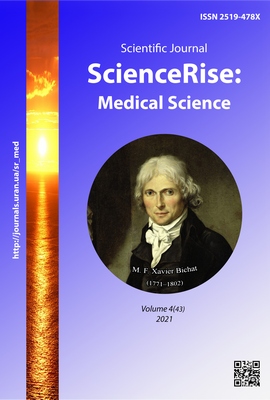Недиференційована дисплазія сполучної тканини як предиктор порушень серцевого ритму у поєднанні з гастроезофагеальною рефлюксною хворобою у дітей
DOI:
https://doi.org/10.15587/2519-4798.2021.238132Ключові слова:
недиференційована дисплазія сполучної тканини, гастроезофагеальна рефлюксна хвороба, аритмія, діти, предикторАнотація
Мета: удосконалити ранню діагностику аритмії у поєднанні з гастроезофагеальною рефлюксною хворобою (ГЕРХ) у дітей, шляхом вивчення ризику впливу сполучнотканинної дисплазії на виникнення даної патології.
Матеріали та методи. Було обстежено 100 дітей віком від 8 до 18 років, середнім віком 13,7±2,7 років, з яких 32 дитини з аритміями без поєднаної патології склали I групу, 36 дітей з супутньою ГЕРХ – II групу та 32 дитини з ГЕРХ без супутньої аритмії – III групу.Пацієнтам були проведені клінічні й інструментальні дослідження (електрокардіографія, холтерівське добове моніторування ЕКГ, езофагогастродуоденоскопія та pH-метрія) та оцінка фенотипових ознак НДСТ за критеріями Т. Мілковської-Димитрової і А. Каркашова.
Результати. Був визначений фактор ризику для формування у дітей поєднаної патології у вигляді аритмії та ГЕРХ, а саме наступна головна фенотипова ознака НДСТ (недиференційованої дисплазії сполучної тканини) – диспластичний ріст зубів.
Також, були виявлені предиктори як ізольованого варіанту перебігу аритмії у дітей, так і аритмії у поєднанні з ГЕРХ – високий зріст та сколіотична постава.
При цьому, фактором ризику виникнення ізольованого варіанту перебігу аритмії у дітей, згідно результатам дослідження є астенічна конституція.
Визначені ступені вираженості НДСТ у досліджуваних групах. При аналізі результатів було визначено відсутність статистично значущого зв’язку між ступенем виразності НДСТ і групами дослідження, хоча слід відмітити, що у дітей III групи перший ступінь НДСТ не відмічався взагалі.
Висновки. Виявлено, що астенічна конституція, диспластичний ріст зубів, високий зріст і сколіотична постава є статистично достовірними факторами ризику виникнення досліджуваних патологій.
Між досліджуваними групами не визначено статистично значущих відмінностей відносно ступенів виразності НДСТ, проте відмічена повна відсутність виявлення у дітей III групи (діти з ізольованим перебігом ГЕРБ без супутньої аритмії) першого ступеню НДСТ
Посилання
- Skirda, I. Y., Petishko, O. P., Zavgorodnyaya, N. Y. (2017). Epidemiological features of diseases of the digestive system in children and adolescents in Ukraine. Gastroenterology, 51 (4), 229–236. doi: http://doi.org/10.22141/2308-2097.51.4.2017.119287
- Yang, A., Kang, B., Choe, J. Y., Kim, H. S., Kim, K., Choe, Y. H. (2017). Prevalence and Epidemiological Characteristics of Endoscopically Proven Reflux Esophagitis in Children in Korea. Pediatric Gastroenterology, Hepatology & Nutrition, 20 (3), 160–166. doi: http://doi.org/10.5223/pghn.2017.20.3.160
- Melnyk, O., Samoilenko, I., Ptyshnyk, I. (2021). Problema hastroezofahealnoi refliuksnoi khvoroby u nemovliat ta ditei shkilnoho viku. Hraal Nauky, 2-3, 583–584. doi: http://doi.org/10.36074/grail-of-science.02.04.2021.118
- Hunt, R., Armstrong, D., Katelaris, P., Afihene, M., Bane, A., Bhatia, S. et. al. (2017). World Gastroenterology Organisation Global Guidelines. Journal of Clinical Gastroenterology, 51 (6), 467–478. doi: http://doi.org/10.1097/mcg.0000000000000854
- Gonzalez Ayerbe, J. I., Hauser, B., Salvatore, S., Vandenplas, Y. (2019). Diagnosis and Management of Gastroesophageal Reflux Disease in Infants and Children: from Guidelines to Clinical Practice. Pediatric Gastroenterology, Hepatology & Nutrition, 22 (2), 107–121. doi: http://doi.org/10.5223/pghn.2019.22.2.107
- Rybak, A., Pesce, M., Thapar, N., Borrelli, O. (2017). Gastro-Esophageal Reflux in Children. International Journal of Molecular Sciences, 18 (8), 1671. doi: http://doi.org/10.3390/ijms18081671
- Blaufox, A. D. (2018). Irregular heart rhythm (arrhythmias) in children. Waltham.
- Osteraas, N. (2021). Neurologic complications of brady-arrhythmias. Heart and Neurologic Disease. Elsevier, 163–174. doi: http://doi.org/10.1016/b978-0-12-819814-8.00006-8
- Lakshmanadoss, U. (Ed.). (2020). Differential Diagnosis of Chest Pain. BoD–Books on Demand. DOI: 10.5772/intechopen.7887
- Rees, C. J., Cantor, R. M., Pollack, Jr. C. V., Riese, V. G.; Pollack, Jr. C. (Ed.) (2019). Gastroesophageal Reflux Disease. Differential Diagnosis of Cardiopulmonary Disease. Cham: Springer, 441–449. doi: http://doi.org/10.1007/978-3-319-63895-9_30
- Romash, I. B., Mishchuk, V. G. (2020). The frequency of visceral and phenotypic markers in patients with the combination of undifferentiated connective tissue disease and gastroesophageal reflux disease. Wiadomości Lekarskie, 73 (7), 1492–1498. doi: http://doi.org/10.36740/wlek202007134
- Lukianenko, N. S., Petritsa, N. A., Kens, K. A. (2015). Place of undifferentiated connective tissue dysplasia in childhood pathology (literature review). Zdorove rebenka, 2, 80–85. Available at: http://nbuv.gov.ua/UJRN/Zd_2015_2_18
- Shodikulova, G. Z. (2017). Special features of clinical and functional disorders in patients with undifferentiated connective tissue dysplasia. European Science Review, 72–74. doi: http://doi.org/10.29013/esr-17-3.4-72-74
- Apenchenko, Yu. S., Basalaeva, N. V., Kapustina, L. V., Ivanova, I. I. (2014). Klinicheskie i biokhimicheskie priznaki displazii soedinitelnoy tkani u detey s gastroezofagealnoy reflyuksnoy boleznyu. Vestnik Ivanovskoy meditsinskoy akademii, 19 (3), 17–19.
- Nica, A. E., Alexa, L. M., Ionescu, A. O., Andronic, O., Păduraru, D. N. (2016). Esophageal disorders in mixed connective tissue diseases. Journal of medicine and life, 9 (2), 141.
- Shnitkova, E. V., Sesorova, I. S., Terenteva, T. V., Mozhaeva, A. N. (2016). Phenotypic features and body signs connective tissue dysplasia in neonates with hypoxic-ischemic central nervous system. Mezhdunarodniy nauchno-issledovatelskiy zhurnal, 11-3 (53), 173–175. doi: http://doi.org/10.18454/IRJ.2016.53.195
- Yagoda, A. V., Novikova, M. V., Gladkikh, N. N. (2015). Faktory riska prognosticheski znachimykh narusheniy serdechnogo ritma pri displazii soedinitelnoy tkani. Arkhiv vnutrenney meditsiny, 1, 60–63.
##submission.downloads##
Опубліковано
Як цитувати
Номер
Розділ
Ліцензія
Авторське право (c) 2021 Oksana Herasymova, Tetiana Filonova

Ця робота ліцензується відповідно до Creative Commons Attribution 4.0 International License.
Наше видання використовує положення про авторські права Creative Commons CC BY для журналів відкритого доступу.
Автори, які публікуються у цьому журналі, погоджуються з наступними умовами:
1. Автори залишають за собою право на авторство своєї роботи та передають журналу право першої публікації цієї роботи на умовах ліцензії Creative Commons CC BY, котра дозволяє іншим особам вільно розповсюджувати опубліковану роботу з обов'язковим посиланням на авторів оригінальної роботи та першу публікацію роботи у цьому журналі.
2. Автори мають право укладати самостійні додаткові угоди щодо неексклюзивного розповсюдження роботи у тому вигляді, в якому вона була опублікована цим журналом (наприклад, розміщувати роботу в електронному сховищі установи або публікувати у складі монографії), за умови збереження посилання на першу публікацію роботи у цьому журналі.










